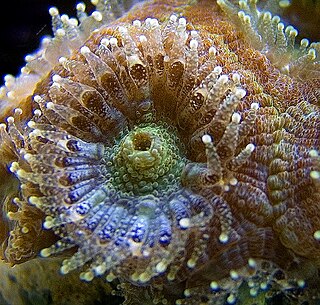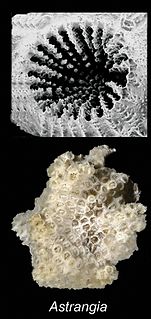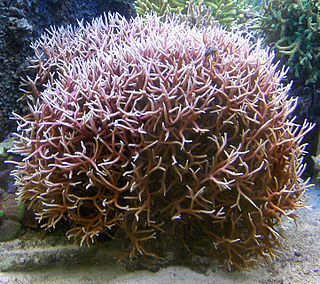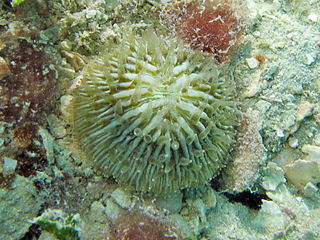
A polyp in zoology is one of two forms found in the phylum Cnidaria, the other being the medusa. Polyps are roughly cylindrical in shape and elongated at the axis of the vase-shaped body. In solitary polyps, the aboral end is attached to the substrate by means of a disc-like holdfast called the pedal disc, while in colonies of polyps it is connected to other polyps, either directly or indirectly. The oral end contains the mouth, and is surrounded by a circlet of tentacles.

Corals are marine invertebrates within the class Anthozoa of the phylum Cnidaria. They typically live in compact colonies of many identical individual polyps. Coral species include the important reef builders that inhabit tropical oceans and secrete calcium carbonate to form a hard skeleton.

Anthozoa is a class of marine invertebrates which includes the sea anemones, stony corals and soft corals. Adult anthozoans are almost all attached to the seabed, while their larvae can disperse as part of the plankton. The basic unit of the adult is the polyp; this consists of a cylindrical column topped by a disc with a central mouth surrounded by tentacles. Sea anemones are mostly solitary, but the majority of corals are colonial, being formed by the budding of new polyps from an original, founding individual. Colonies are strengthened by calcium carbonate and other materials and take various massive, plate-like, bushy or leafy forms.

Scleractinia, also called stony corals or hard corals, are marine animals in the phylum Cnidaria that build themselves a hard skeleton. The individual animals are known as polyps and have a cylindrical body crowned by an oral disc in which a mouth is fringed with tentacles. Although some species are solitary, most are colonial. The founding polyp settles and starts to secrete calcium carbonate to protect its soft body. Solitary corals can be as much as 25 cm (10 in) across but in colonial species the polyps are usually only a few millimetres in diameter. These polyps reproduce asexually by budding, but remain attached to each other, forming a multi-polyp colony of clones with a common skeleton, which may be up to several metres in diameter or height according to species.

Sea anemones are the marine, predatory animals of the order Actiniaria. They are named after the anemone, a terrestrial flowering plant, because of the colourful appearance of many. Sea anemones are classified in the phylum Cnidaria, class Anthozoa, subclass Hexacorallia. As cnidarians, sea anemones are related to corals, jellyfish, tube-dwelling anemones, and Hydra. Unlike jellyfish, sea anemones do not have a medusa stage in their life cycle.

Porites astreoides, commonly known as mustard hill coral or yellow porites, is a colonial species of stony coral in the family Poritidae.

Pocillopora is a genus of stony corals in the family Pocilloporidae occurring in the Pacific and Indian Oceans. They are commonly called cauliflower corals and brush corals.

Galaxea fascicularis is a species of colonial stony coral in the family Euphylliidae, commonly known as octopus coral, fluorescence grass coral, galaxy coral among various vernacular names.

Siderastrea radians, also known as the lesser starlet coral or the shallow-water starlet coral, is a stony coral in the family Siderastreidae. It is found in shallow parts of the western Atlantic Ocean as small, solid mounds or encrusting sheets.

Scolymia lacera, the fleshy disk coral, is a species of stony coral in the family Mussidae. It occurs on reefs in shallow waters in the Caribbean Sea, the Gulf of Mexico, the Bahamas, Bermuda and southern Florida.

Micromussa lordhowensis, previously known as the 'Acan Lord', is a species of stony coral in the family Lobophylliidae. It is a widespread and common coral with large polyps occurring on shallow reefs in the Indo-Pacific Ocean. It was originally classified under the genus Acanthastrea, and reclassified under the genus Micromussa in 2016.

Caryophyllia smithii, the Devonshire cup coral, is a species of solitary coral in the family Caryophylliidae. It is native to the northeastern Atlantic Ocean, the North Sea and the Mediterranean Sea. There are shallow and deep-water forms which are structurally different. It forms part of a biodiverse community of rock encrusting organisms and is often parasitised by a barnacle.

Astrangia poculata, the northern star coral or northern cup coral, is a species of non-reefbuilding stony coral in the family Rhizangiidae. It is native to shallow water in the western Atlantic Ocean and the Caribbean Sea. It is also found on the western coast of Africa. The International Union for Conservation of Nature lists this coral as being of "least concern". Astrangia poculata is an emerging model organism for corals because it harbors a facultative photosymbiosis, is a calcifying coral, and has a large geographic range. Research on this emerging model system is showcased annually by the Astrangia Research Working Group, collaboratively hosted by Roger Williams University, Boston University, and Southern Connecticut State University

Seriatopora hystrix is a species of colonial stony coral in the family Pocilloporidae. It forms a branching clump and is commonly known as thin birdsnest coral. It grows in shallow water on fore-reef slopes or in sheltered lagoons, the type locality being the Red Sea. It is native to East Africa, the Red Sea and the western Indo-Pacific region. It is a common species and the International Union for Conservation of Nature has assessed its conservation status as being of "least concern".
Rhytisma fulvum, the sulphur leather coral, is a species of colonial soft coral in the family Alcyoniidae. It is native to shallow reefs in the Red Sea and the Indo-Pacific region. It was first described by the Swedish naturalist Peter Forsskål in 1775.

Madracis auretenra, commonly known as the yellow finger coral or yellow pencil coral, is a colonial species of stony coral in the family Pocilloporidae. It is a fairly common species and is found in the Caribbean Sea and western Atlantic Ocean. At one time this species was not recognised, but it was split from Madracis mirabilis on the grounds of morphology and depth range.

Manicina areolata, commonly known as rose coral, is a colonial species of stony coral. It occurs in shallow water in the West Atlantic Ocean and Caribbean Sea, sometimes as small solid heads and sometimes as unattached cone-shaped forms.
Flabellum pavoninum is a species of deep sea coral belonging to the family Flabellidae. It is found in the western Indo-Pacific Ocean at depths varying from 73 to 665 m. They are sometimes known as dentures of the sea because of the perceived resemblance of the corallum (skeleton) to a set of dentures.

Balanophyllia elegans, the orange coral or orange cup coral, is a species of solitary cup coral, a stony coral in the family Dendrophylliidae. It is native to the eastern Pacific Ocean. As an azooxanthellate species, it does not contain symbiotic dinoflagellates in its tissues in the way that most corals do.

Cycloseris cyclolites is a species of disc coral in the family Fungiidae. It was first described by the French naturalist Jean-Baptiste Lamarck in 1815. It is native to the tropical and subtropical Indo-Pacific region where it is found on soft sediment in shallow water.
















